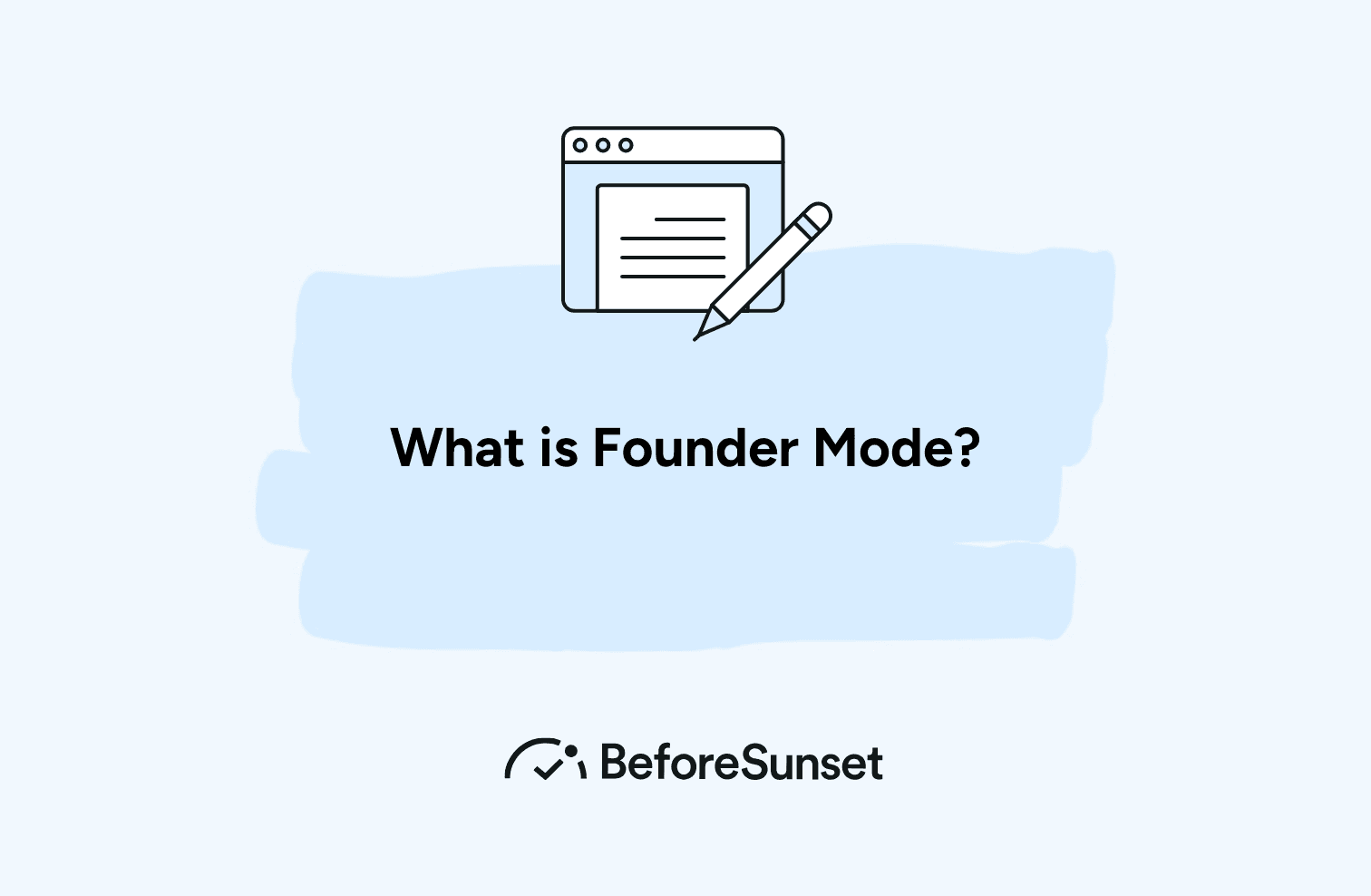Have you ever wondered why some startup founders seem to do things differently than what business books tell them to do? This interesting new way of running companies called "founder mode" is making waves in the startup world.
It goes against everything we've been taught about how successful companies should be run. But here's the thing - it's working, and it's working well.
You might also like:
The Origins of the Debate
The term gained significant attention after Paul Graham, co-founder of Y Combinator, published an insightful essay about how successful founders run their companies differently from professional managers.
This observation came after Brian Chesky of Airbnb shared his experiences at a YC event, revealing how following traditional management advice nearly derailed his company.
Understanding the Two Modes
Manager Mode
Traditional management style centers around what Graham calls "manager mode." This approach, taught in business schools across the globe, emphasizes:
Delegation of responsibilities
Clear hierarchical structures
Minimal involvement in day-to-day operations
Trust in middle management
Reliance on professional expertise
Founder Mode
In contrast, founder mode represents a more hands-on, deeply involved approach to leadership. Key characteristics include:
Direct engagement with all levels of the company
Deep understanding of product and customer needs
Active participation in crucial decisions
Strong vision-driven leadership
Continuous learning and adaptation

The Steve Jobs Example
No discussion about founder mode would be complete without mentioning Steve Jobs. His approach to running Apple exemplified founder mode at its best:
Maintained deep involvement in product development
Regularly engaged with employees at all levels
Kept direct connection with customer needs
Focused on innovation and excellence over bureaucracy
Common Challenges and Solutions
Implementing founder mode is a pivotal strategy for many leaders looking to drive innovation and maintain a startup’s original vision as the company scales. However, this approach is not without its challenges.
As organizations grow, leaders must navigate a myriad of complexities that can hinder their effectiveness and the overall company culture. Understanding these challenges and proactively addressing them is crucial for founders aiming to cultivate a thriving business environment.
When implementing founder mode, leaders often face several challenges:
• Scale-related complexities: As companies grow, processes that worked well in the early stages may become cumbersome, leading to inefficiencies and confusion.
• Time management: Founders frequently find themselves pulled in multiple directions, struggling to allocate time effectively between strategic initiatives and day-to-day operations.
• Team empowerment: Balancing involvement with allowing team members the autonomy to make decisions can be tricky. Over-involvement can stifle creativity and initiative among team members.
• Balance between involvement and micromanagement: While it’s essential for founders to stay connected with their teams, excessive oversight can lead to frustration and disengagement.
To address these challenges, successful founders typically:
• Create efficient communication systems: Establishing clear channels for communication helps ensure everyone is aligned and informed, minimizing misunderstandings and delays.
• Build strong leadership teams that share their vision: By surrounding themselves with leaders who understand and embrace the company’s mission, founders can delegate effectively and foster a collaborative culture.
• Implement technology tools for better oversight: Utilizing project management and communication tools can streamline operations, allowing founders to keep tabs on progress without micromanaging.
• Maintain clear priorities and focus areas: By defining key objectives and aligning the team’s efforts around them, founders can reduce chaos and keep everyone focused on what matters most.
While the transition to founder mode presents unique challenges, the right strategies can facilitate a smoother implementation. By fostering open communication, empowering teams, and leveraging technology, founders can successfully navigate the complexities of scaling their businesses while preserving the essence of their original vision.
Ultimately, embracing these practices not only strengthens the organization but also ensures its long-term success and innovation.
Building a Strong Team in Founder Mode
Creating a strong team while operating in founder mode requires a distinctive approach that aligns with the founder’s vision and mission. Here are some strategies to build an effective team:
1. Focus on Hiring People Who Share the Founder’s Vision: It’s essential to recruit individuals who resonate with the founder’s core values and long-term goals. This alignment ensures that team members are not just skilled but also passionate about the company’s mission, fostering a unified culture.
2. Encourage Direct Communication Across All Levels: Open lines of communication can significantly enhance collaboration and problem-solving. By promoting a culture where team members feel comfortable sharing their ideas and concerns, founders can harness diverse perspectives that lead to innovative solutions.
3. Maintain Transparency in Decision-Making: Transparent decision-making processes build trust within the team. When employees understand the rationale behind key decisions, they are more likely to feel invested in the outcomes and motivated to contribute their best efforts.
4. Foster a Culture of Innovation and Experimentation: Encouraging a mindset of experimentation allows team members to explore new ideas without fear of failure. This culture not only drives innovation but also empowers employees to take initiative, leading to creative solutions that can propel the company forward.
The Rise of Female Founders
In recent years, female founders have emerged as formidable leaders, successfully implementing founder mode with a fresh perspective. Women often bring unique insights and approaches to leadership, challenging traditional management paradigms.
Their success stories underscore the idea that effective leadership transcends gender; it hinges on vision, resilience, and the ability to inspire teams. From diverse industries, these leaders have demonstrated that adopting founder mode can foster innovation and drive growth, creating a supportive ecosystem for future female entrepreneurs.
From Beverage Company to Tech Giant
The story of John Sculley serves as a poignant reminder of the importance of industry-specific experience in leadership roles. Transitioning from a beverage company to lead Apple, Sculley initially relied on traditional management approaches that clashed with the dynamic, fast-paced environment of the tech industry.
This contrast highlights how crucial it is for leaders in tech companies to embrace the founder mode mentality, which prioritizes adaptability and a deep understanding of the industry landscape. Leaders who can blend their unique backgrounds with the demands of their sector are more likely to succeed in fostering innovation and driving their companies forward.
Founder After Founder: Success Stories
The narratives of successful founders reinforce the effectiveness of maintaining a hands-on approach while scaling businesses.
Notable figures like Jeff Bezos of Amazon and Mark Zuckerberg of Meta have exemplified how staying deeply involved in their companies can lead to sustained growth and innovation.
These leaders consistently demonstrate that founder mode isn’t just a phase but a vital aspect of leadership that can propel organizations to new heights. By remaining engaged with their teams and the operational intricacies of their businesses, they foster a culture of agility and responsiveness, allowing them to navigate challenges and seize opportunities in an ever-evolving market landscape.

BeforeSunset AI: A Solution for Founders
Let's look at a practical example of founder mode in action with BeforeSunset AI, a tool that's actually helping founders and teams manage their time better.
Think about it - when you're running your company in founder mode, one of the biggest challenges is managing your time while staying deeply involved in different aspects of the business.
This is exactly the problem BeforeSunset AI solves.
The platform works as your daily AI assistant, helping founders organize their hectic schedules and prioritize tasks effectively.
What's interesting is how BeforeSunset AI itself operates with founder mode principles - they're constantly talking to users, understanding their pain points, and quickly adapting their product based on real founder feedback.
They're not just building another time management tool; they're creating a solution specifically designed for founders who need to balance deep involvement in their company with efficient time management.
Implementing Founder Mode: Practical Steps
For founders looking to maintain or transition back to founder mode, consider these key steps:
Stay connected to product development
Maintain regular contact with customers
Keep communication channels open across all levels
Participate in key decisions across departments
Continuously learn and adapt to new challenges
Conclusion
Founder mode represents a powerful alternative to traditional management approaches, particularly in technology-driven companies. While it challenges conventional wisdom, its success in companies like Apple, Amazon, and numerous startups demonstrates its effectiveness.
The key is finding the right balance between hands-on leadership and team empowerment, always keeping the company's vision and innovation at the forefront.
As the business world continues to evolve, founder mode may well become the new standard for running successful technology companies.
It's not just about being a founder - it's about maintaining the entrepreneurial spirit, vision, and direct engagement that made the company successful in the first place.


